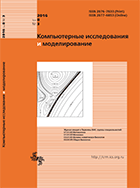All issues
- 2025 Vol. 17
- 2024 Vol. 16
- 2023 Vol. 15
- 2022 Vol. 14
- 2021 Vol. 13
- 2020 Vol. 12
- 2019 Vol. 11
- 2018 Vol. 10
- 2017 Vol. 9
- 2016 Vol. 8
- 2015 Vol. 7
- 2014 Vol. 6
- 2013 Vol. 5
- 2012 Vol. 4
- 2011 Vol. 3
- 2010 Vol. 2
- 2009 Vol. 1
Modeling of plankton community state with density-dependent death and spatial activity of zooplankton
A vertically distributed three-component model of marine ecosystem is considered. State of the plankton community with nutrients is analyzed under the active movement of zooplankton in a vertical column of water. The necessary conditions of the Turing instability in the vicinity of the spatially homogeneous equilibrium are obtained. Stability of the spatially homogeneous equilibrium, the Turing instability and the oscillatory instability are examined depending on the biological characteristics of zooplankton and spatial movement of plankton. It is shown that at low values of zooplankton grazing rate and intratrophic interaction rate the system is Turing instable when the taxis rate is low. Stabilization occurs either through increased decline of zooplankton either by increasing the phytoplankton diffusion. With the increasing rate of consumption of phytoplankton range of parameters that determine the stability is reduced. A type of instability depends on the phytoplankton diffusion. For large values of diffusion oscillatory instability is observed, with a decrease in the phytoplankton diffusion zone of Turing instability is increases. In general, if zooplankton grazing rate is faster than phytoplankton growth rate the spatially homogeneous equilibrium is Turing instable or oscillatory instable. Stability is observed only at high speeds of zooplankton departure or its active movements. With the increase in zooplankton search activity spatial distribution of populations becomes more uniform, increasing the rate of diffusion leads to non-uniform spatial distribution. However, under diffusion the total number of the population is stabilized when the zooplankton grazing rate above the rate of phytoplankton growth. In general, at low rate of phytoplankton consumption the spatial structures formation is possible at low rates of zooplankton decline and diffusion of all the plankton community. With the increase in phytoplankton predation rate the phytoplankton diffusion and zooplankton spatial movement has essential effect on the spatial instability.
Copyright © 2016 Giricheva E.E.
- . Investigation of Turing structures formation under the influence of wave instability. // Computer Research and Modeling. — 2019. — V. 11, no. 3. — P. 397. DOI: 10.20537/2076-7633-2019-11-3-397-412
Indexed in Scopus
Full-text version of the journal is also available on the web site of the scientific electronic library eLIBRARY.RU
The journal is included in the Russian Science Citation Index
The journal is included in the RSCI
International Interdisciplinary Conference "Mathematics. Computing. Education"







